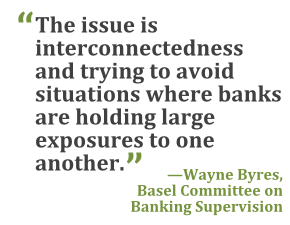Denmark's government said its proposals from May to ease Basel III liquidity rules will probably prevail when the European Commission reveals its final decision on the matter this month.
In an interview yesterday in Copenhagen, Economy Minister Margrethe Vestager said she sees “no reason to believe there are any changes to the proposal” published by her ministry last month.
Denmark, which has spent the past three and a half years battling rules by the Basel Committee on Banking Supervision that the nation says penalize its home finance system, is telling its banks they won't need to follow the global regulator's standards for covered bonds. Vestager said in May her ministry had received assurances from Brussels that Denmark's needs would be taken into account when Europe adapts Basel III to its own markets.
The government in Copenhagen has argued that applying the Basel rules, which limit the asset classes banks can use to fill liquidity reserves, would force lenders in the Nordic country to sell covered bonds. The Danish mortgage industry says there aren't enough government bonds—favored under Basel—to fill the gap, because the AAA-rated nation doesn't have enough public debt. Banks currently use mortgage-backed covered bonds to meet about 70 percent of their liquidity needs, versus a 40 percent cap set by Basel.
 Denmark said last month that the European Commission will recommend letting banks hold 75 percent more in covered bonds than Basel III rules allow. Though the commission still has until June 30 to reveal its final decision, the development marks a victory for Denmark, which doesn't hold a seat on the 27-member Basel committee.
Denmark said last month that the European Commission will recommend letting banks hold 75 percent more in covered bonds than Basel III rules allow. Though the commission still has until June 30 to reveal its final decision, the development marks a victory for Denmark, which doesn't hold a seat on the 27-member Basel committee.
Banks will be allowed to book the most liquid covered bonds at 93 percent of their market value, compared with Basel's target of 85 percent, according to Denmark's economy ministry. Lenders will also be free to use the bonds for as much as 70 percent of their liquidity buffers. The plan applies to all European covered bonds that meet “certain criteria,” according to the ministry, which cited a European Union (EU) commission proposal that Brussels has yet to publish.
To be included in the top liquidity bracket, covered bonds must carry a high credit rating and be issued in sizes of at least 500 million euros (US$681 million), the ministry said. The bonds also need to be over-collateralized, it said.
Basel III rules had reserved the top liquidity status for bonds sold by governments, even those bailed out during Europe's debt crisis. The so-called Level 1 designation allowed banks to hold unlimited stores of sovereign debt at market value.
Basel Clashes
Denmark's insistence on shaping Basel rules to protect its $550 billion mortgage-bond market, the world's largest per capita, has met some resistance.
The European Union's implementation of Basel bank rules already “deviates on some important points” from international standards, Karel Lannoo, chief executive officer of the Centre for European Policy Studies in Brussels, said by telephone in May. “These are not details; these are essential issues,” he said. “This latest example is no reassurance whatsoever.”
Like other governmental bodies, the EU is under scrutiny from the Basel committee on how well it implements the group's rules.
This has already led to one clash, after a preliminary international assessment published in October 2012 found that EU plans on bank capital “departed from the Basel framework in many areas.”
The findings were challenged by Michel Barnier, the EU's financial services chief, who said that the Basel report didn't “appear to be supported by rigorous evidence and a well-defined methodology.”
At Basel, the view is that allowing covered bonds to count towards the liquidity coverage ratio was a “concession” to the asset class, according to Wayne Byres, the committee's secretary general.
“It's not about denying that they're liquid,” he said in an interview in the Swiss city last week. “The issue is interconnectedness and trying to avoid situations where banks are simply holding large exposures to one another. Because then in a systemic crisis, the contagion can become much, much worse much, much faster than it might otherwise do.”
Making Exceptions
The Commission is set to present its final proposal by the end of June, which would then be sent for review by governments and the European Parliament.
Under the Basel standard, “for countries that otherwise have a shortage of high-quality liquid assets [HQLA], there are options built into the rules,” Byres said. “One is an expanded use of level 2 assets, which would include greater use of covered bonds. So, it's not as though it was entirely ruled out. It's allowable if there aren't enough HQLA assets around.”
The Liquidity Coverage Ratio is due to fully apply in the EU from 2018, one year ahead of the Basel deadline of 2019.
Barnier said May 20 he's seeking a “pragmatic and at the same time rigorous” solution to the treatment of Danish covered bonds. “I think we will find a solution,” he said.
© 2025 ALM Global, LLC, All Rights Reserved. Request academic re-use from www.copyright.com. All other uses, submit a request to [email protected]. For more information visit Asset & Logo Licensing.




